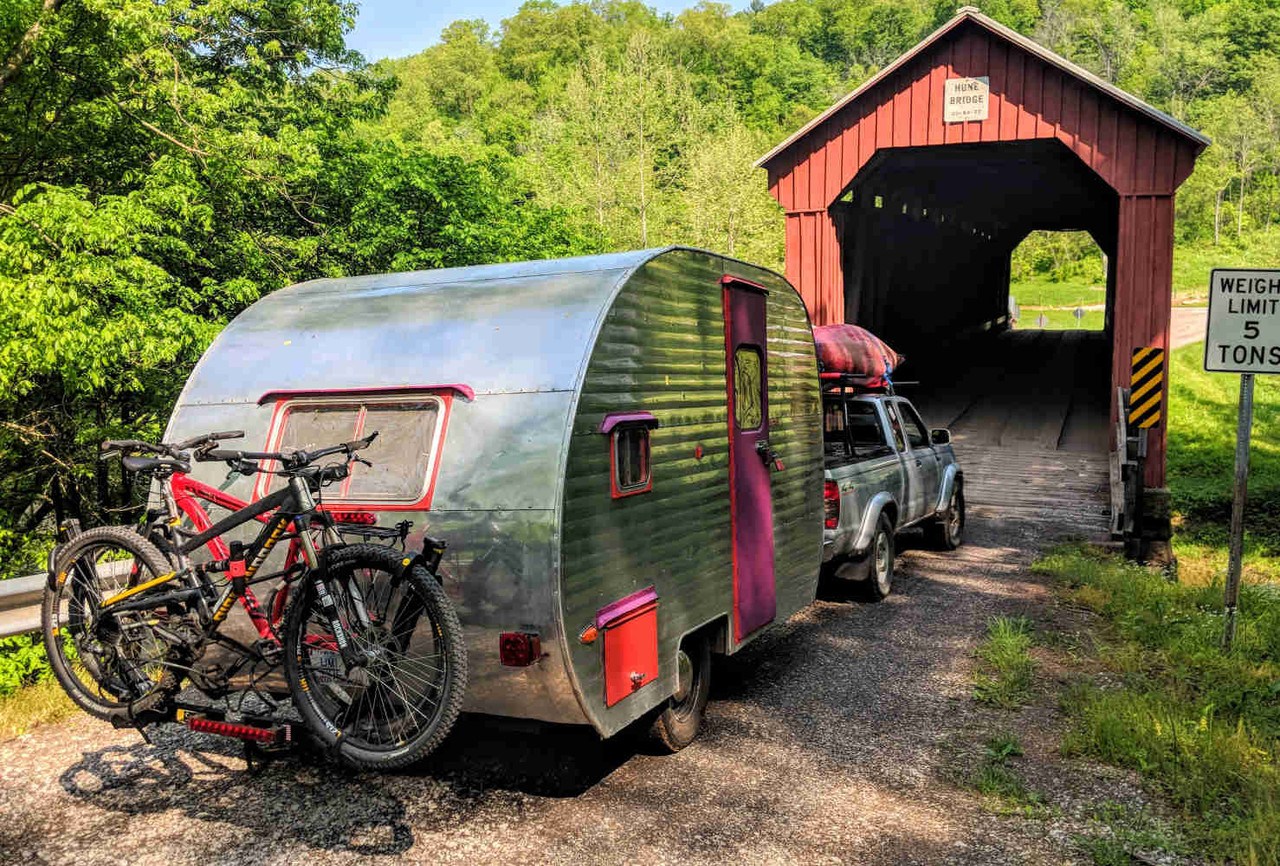Boondocking With Solar
Oh the places you can go…with SOLAR!
“Travelers don’t know where we are going, tourists don’t know
where they’ve been.”
-Paul Theroux
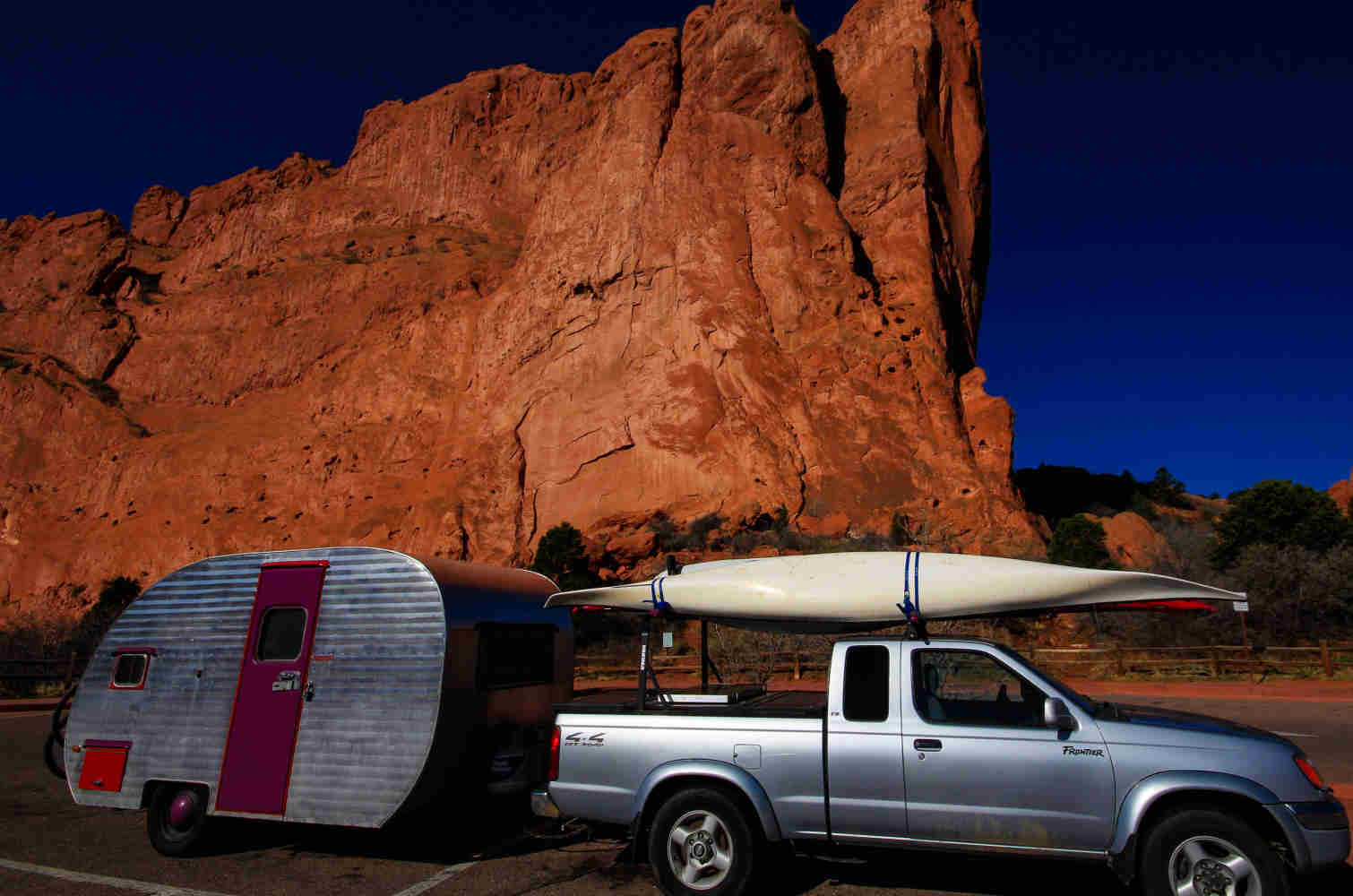
We rarely know where we are going – not because we are lost, but because the journey itself is part of the adventure. Many times, this means we don’t know where we’ll spend the night. Our choices depend on how far we want to drive and what captures our imagination along the way. We frequently find ourselves parked far off the grid, on top of a mountain, along a coastal highway, on BLM land, in a national forest, or tucked into a quiet neighborhood, or even sometimes a Walmart parking lot when public lands feel too far away to reach by sundown.
One thing we can count on in our wanderings is that the sun will rise and illuminate our solar panel, giving us the energy we need to power our lives – pretty much no matter where we are. Traveling during the winter months or days of endless rain can be challenging, but with some battery strategy , we make it work during times when we crave sunshine.
And we aren’t the only ones living this way. We’ve shared space, meals and conversations with other road warriors embracing the freedom found in going solar. Their set-ups vary from the simple and inexpensive to the elaborate and powerful.
If you’ve ever had a desire to live on the road in your dream rig, but aren’t keen on squeezing yourself into an RV parking lot, or paying the high prices for an electrical hook-up at a campsite, read on. Your menu of camping options has just increased by a factor of 100. There are literally thousands of places across the US and Canada that offer gorgeous campsites with no electrical hook-ups, but plenty of space for RV’s of every size.
If you think that off-grid solar panels are only for the southwestern desert, think again. We have found it possible to live mobile with solar for 6.5 years, everywhere from California to Maine and Washington to Florida. We’ve found may amazing places to camp over the years from one coast to the next; here are a few highlights to get stoke your off-grid solar dreams.
Pacific Northwest
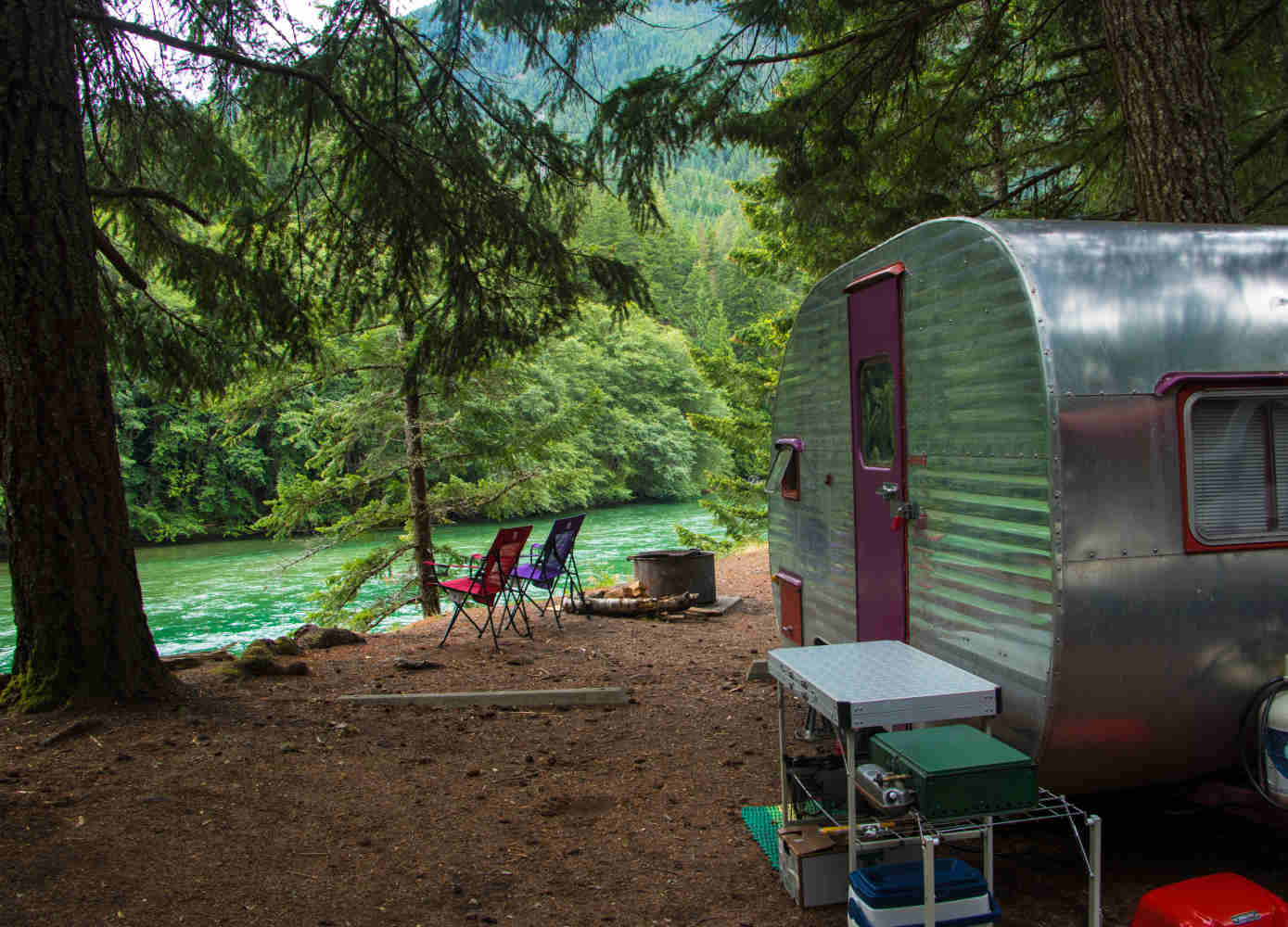
We camp beneath towering Ponderosa pines, along a babbling stream, and find ourselves completely alone. The sun shines through the canopy casting dappled light on the forest floor littered with needles and cones. We set up our camp chairs, pour glasses of wine, and settle into the quiet of our own thoughts.
The North Cascade mountain range divides Washington into distinctly different ecosystems. The west side is wet, cool, and covered in more green moss and icy peaks than you can imagine. But just 30 miles to the east, the environment feels like the high desert, arid, sunny and with less vegetation. While working in the North Cascades National Park just west of Washington Pass along Hwy 20, we found ourselves craving a change of environment from time to time
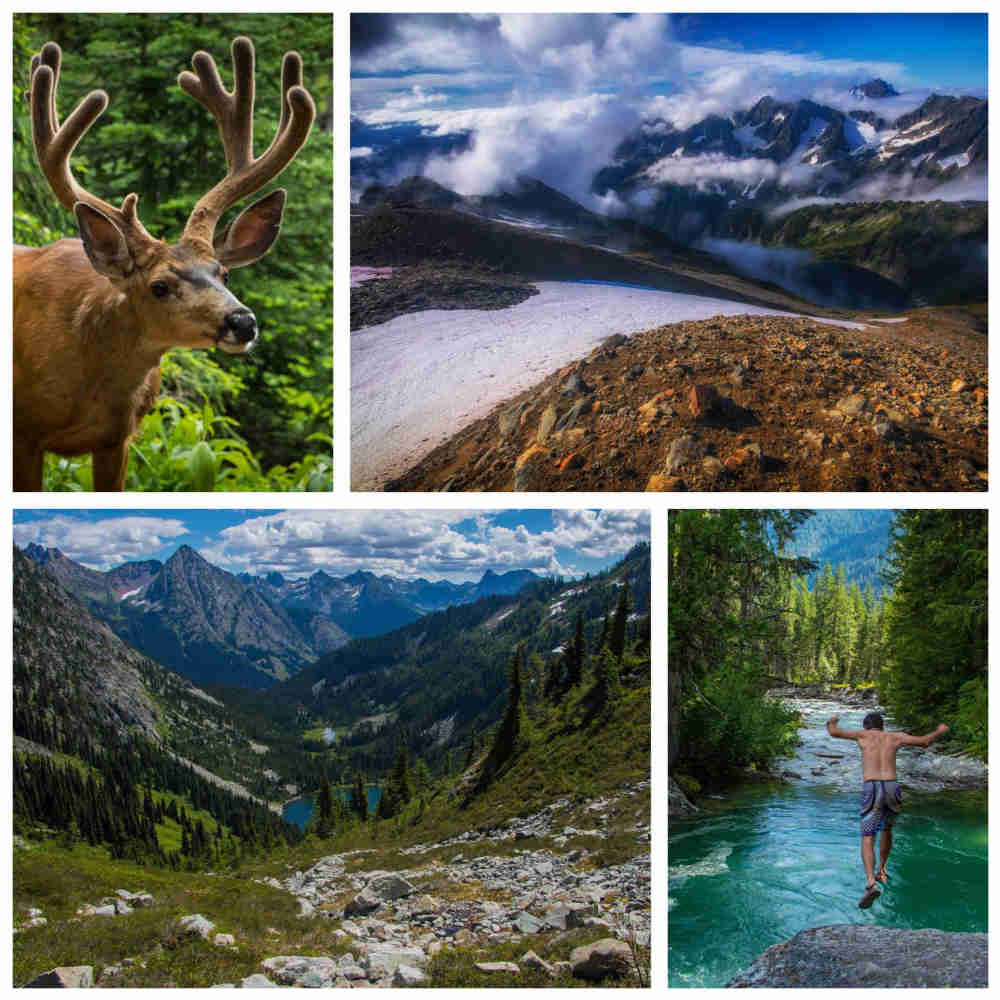
Whenever we got the chance, when the incessant drizzle got the better of us, we’d drive east to dry out in the Methow River Valley, near the towns of Mazama, Winthrop, and Twisp. Forest Service and BLM campsites are scattered across the region and offer amazing recreational opportunities for climbers, hikers, mountain bikers, horseback riders, OHV enthusiasts, and anyone who just wants to sit in the woods. There are a few private campgrounds and RV resorts offering full services, but those won’t get you out into the beautiful mountains of the eastern Cascades. Here, we only needed to set our solar generator out into the sunshine for a few hours to charge up everything we needed.
Southeast
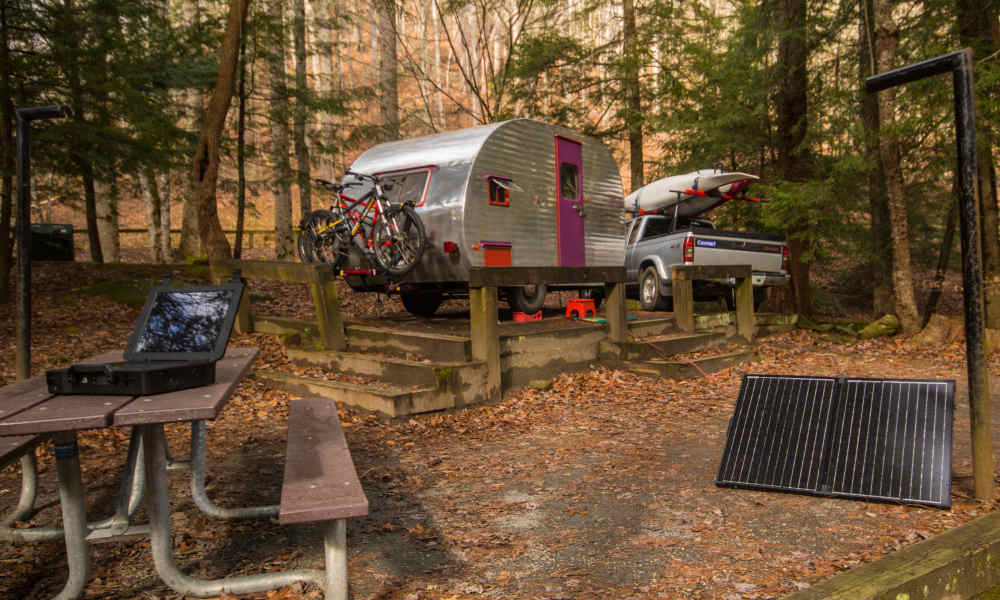
The weather is nearly perfect, warm,
sunny and dry, though February isn’t even over. Our campsite overlooks
the lake and the surrounding Appalachian mountain ridges. The fire ring is loaded with downed wood
gathered by the previous visitor.
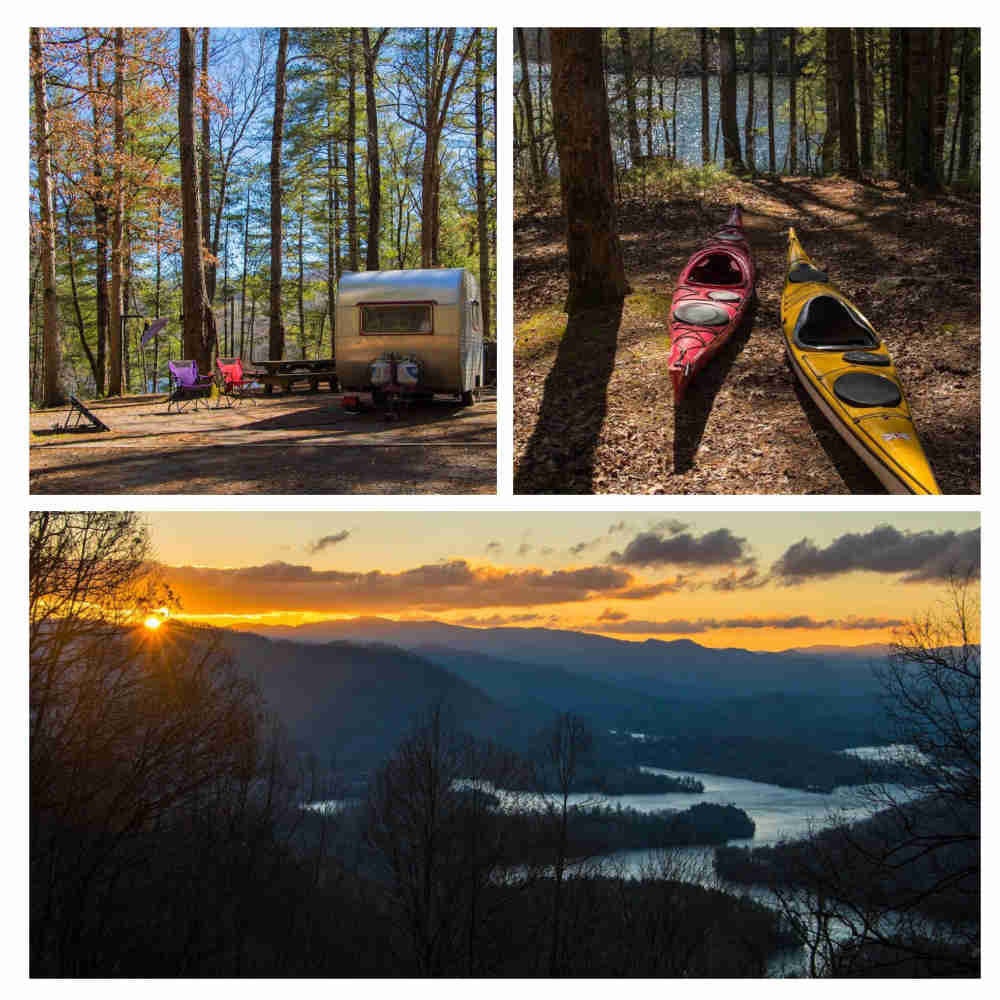
As the higher elevations of North Carolina were hit with snow, we retreated to our home state’s southwest corner near the Georgia and Tennessee lines. Lake Santeetlah is a stunning reservoir and much of the shoreline falls within the national forest. Many campsites along the lakeshore are free or very low cost. Spend the week paddling on the lake or whitewater creeks, hiking among the old-growth forest, and cycling solitary roads as we did, and you’ll be sure to fall for the magic of this place. Even with spring leaves bursting and a canopy of conifers we found enough solar gain to keep the lights on and our various writing projects moving forward.
Midwest
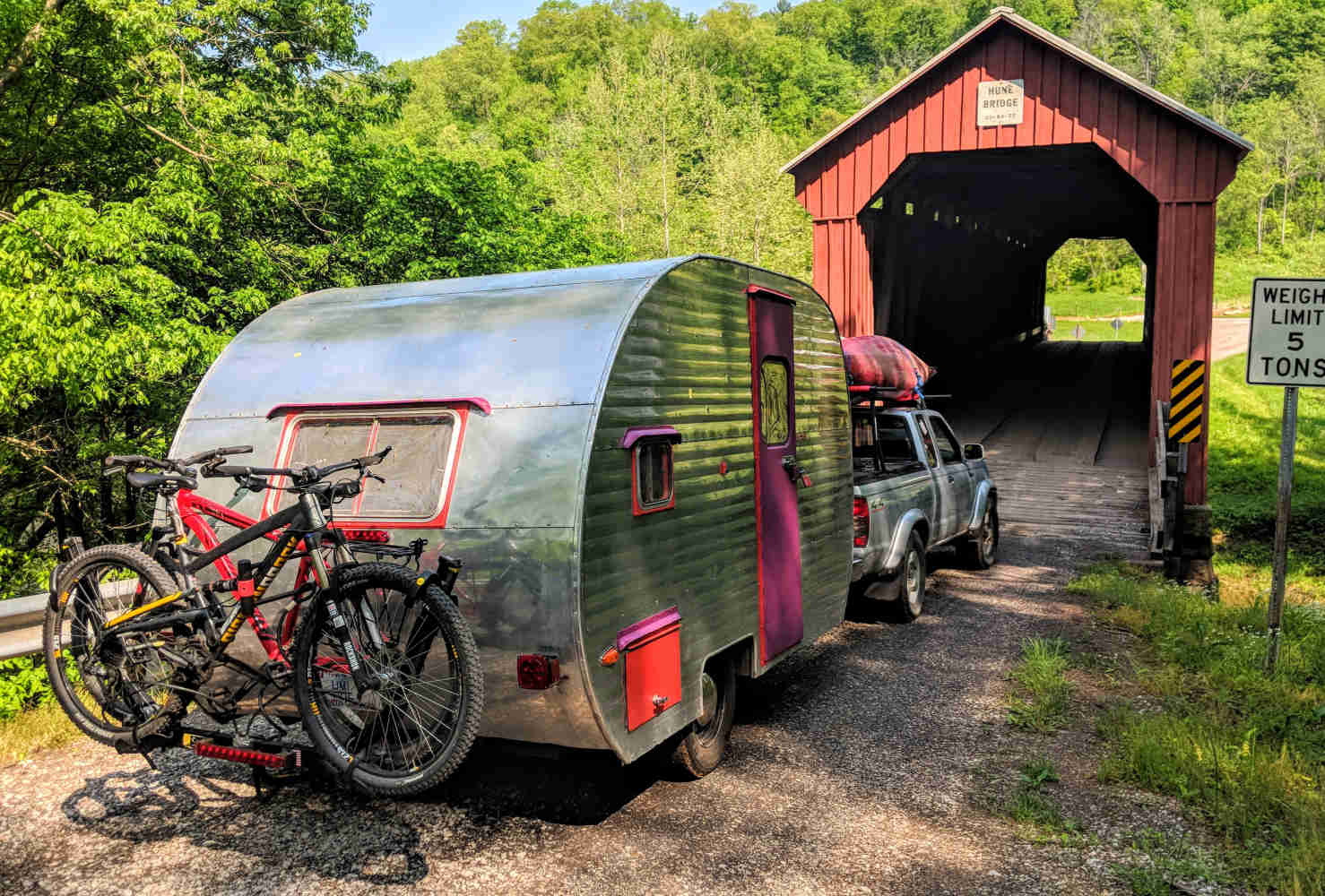
Shari gets out of the truck to get another perspective, making sure that our camper will fit through the picturesque covered bridge. Our rig is vintage, but it’s less than half as old as this bridge crossing the Little Muskingum River. Our campground for the next few days offers just 4 cozy sites tucked beside this historic landmark.
Along the banks of the Ohio River lies the Wayne National Forest that offers great free and low-cost camping in the rolling foothills of the Appalachian Mountains. Cycle along winding country roads acrross antique covered bridges, canoe on the many winding rivers, or hike along the North Coast Trail. We choose a great time to visit while the wildflowers were in the bloom, but the summer’s humidity and heat had not yet kicked in. We stayed in this region for nearly 2 weeks, getting out every day on our bikes, preparing for a 200-mile bikepacking trip through northeastern Ohio later in the month.
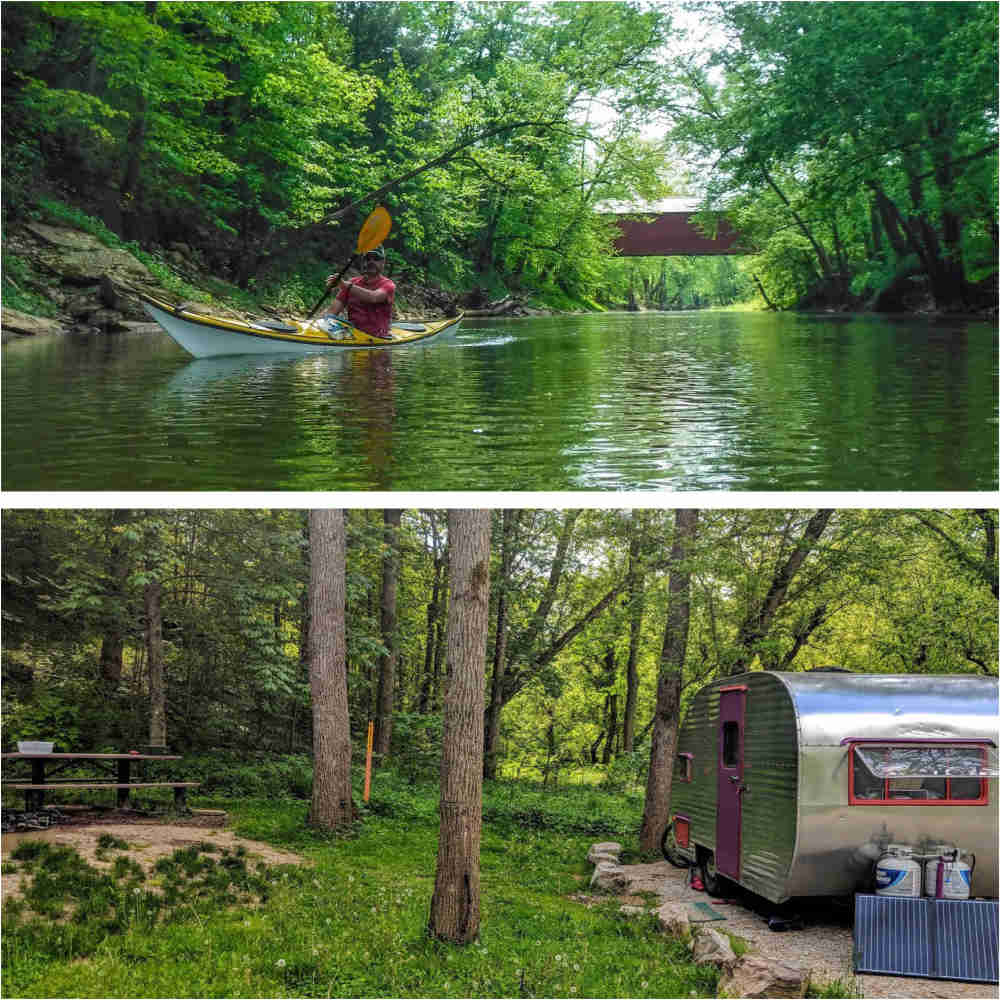
Even through the canopy of maple, buckeye and magnolia, we managed to find a good enough location to set up our solar panel by adding an extension cord. All we needed was just a few hours of good sunlight each day and our battery stayed topped up.
Northeast
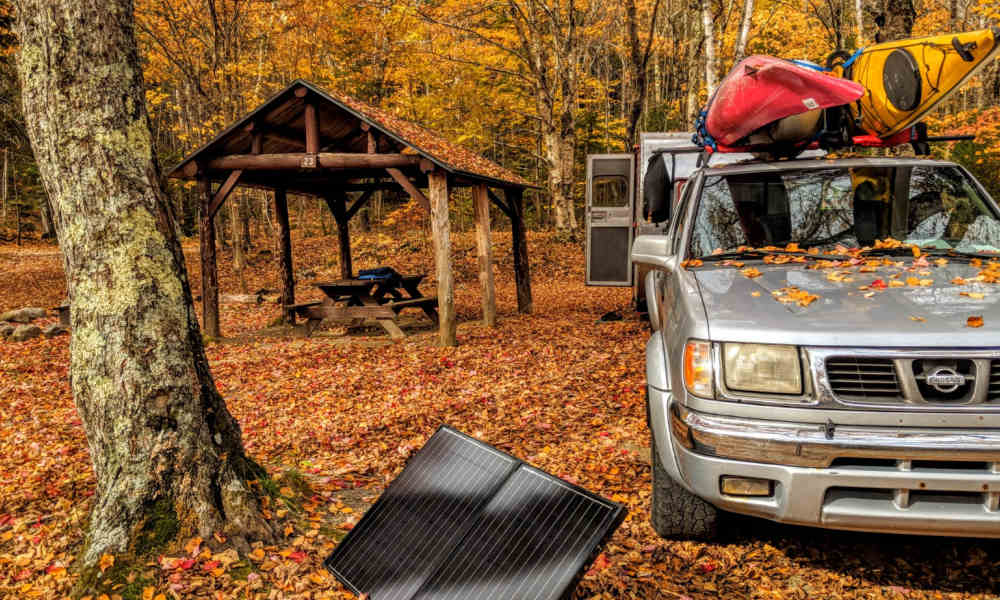
We back into our campsite amid a swirling tide of bright autumn leaves crunching beneath our tires and feet. The volume of fallen leaves alone claim that few remain on the trees, but the colors flashing across the valley and mountainside suggests otherwise. How many leaves can these trees hold?
This iconic, Maine state park is unlike any in the country that we’ve experienced. Larger than New York City, Baxter State Park can only be accessed along the winding dirt two-track roads or miles and miles of foot trails, leading up some of the most challenging hikes in the state. In fact, the campground we stayed is just 5.2 miles from the north terminus of the famous Appalachian Trail. During our stay, we saw hundreds of through-hikers concluding their 5-month journey from Georgia, after summiting the final challenging peak of Mt. Katahdin.
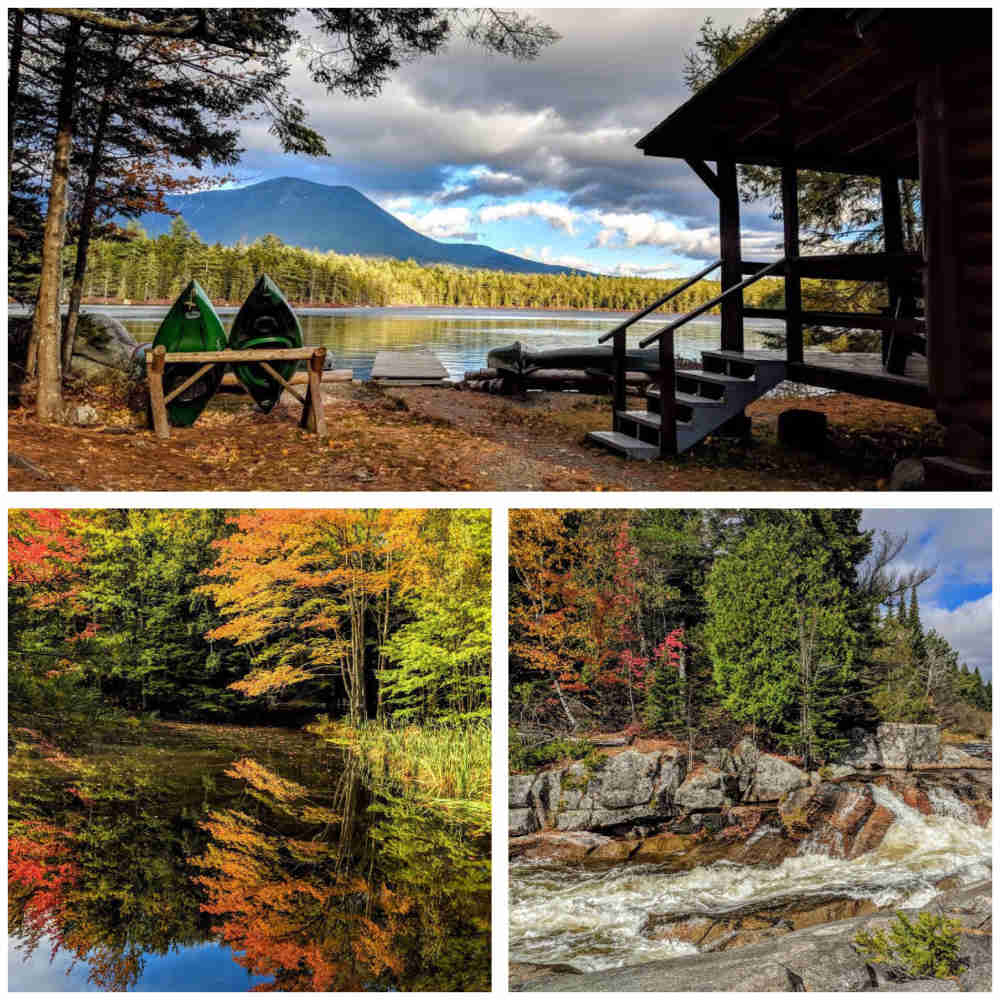
The founding ethic of the park to
make no improvements or build structures which change the fundamental
wilderness aspect of the park, remains its guiding principle. This rustic
ethic draws crowds from all over the world.
Its difficult access is intentional and the payoff is some of the least
spoiled wilderness in the northeast.
Neither RV’s longer than 18 feet nor generators are even allowed within
the park boundaries.
We arrived during the last week that the campgrounds are open in October. The trees were bursting with a rainbow of autumn color, and the nights were near freezing, but we had an amazing time hiking and cycling nearly alone along the many winding trails. The solar panel worked just fine, and we were able to keep the lights on and the camera charged for daily nature photography sessions, but we still didn’t find any moose!
Southwest
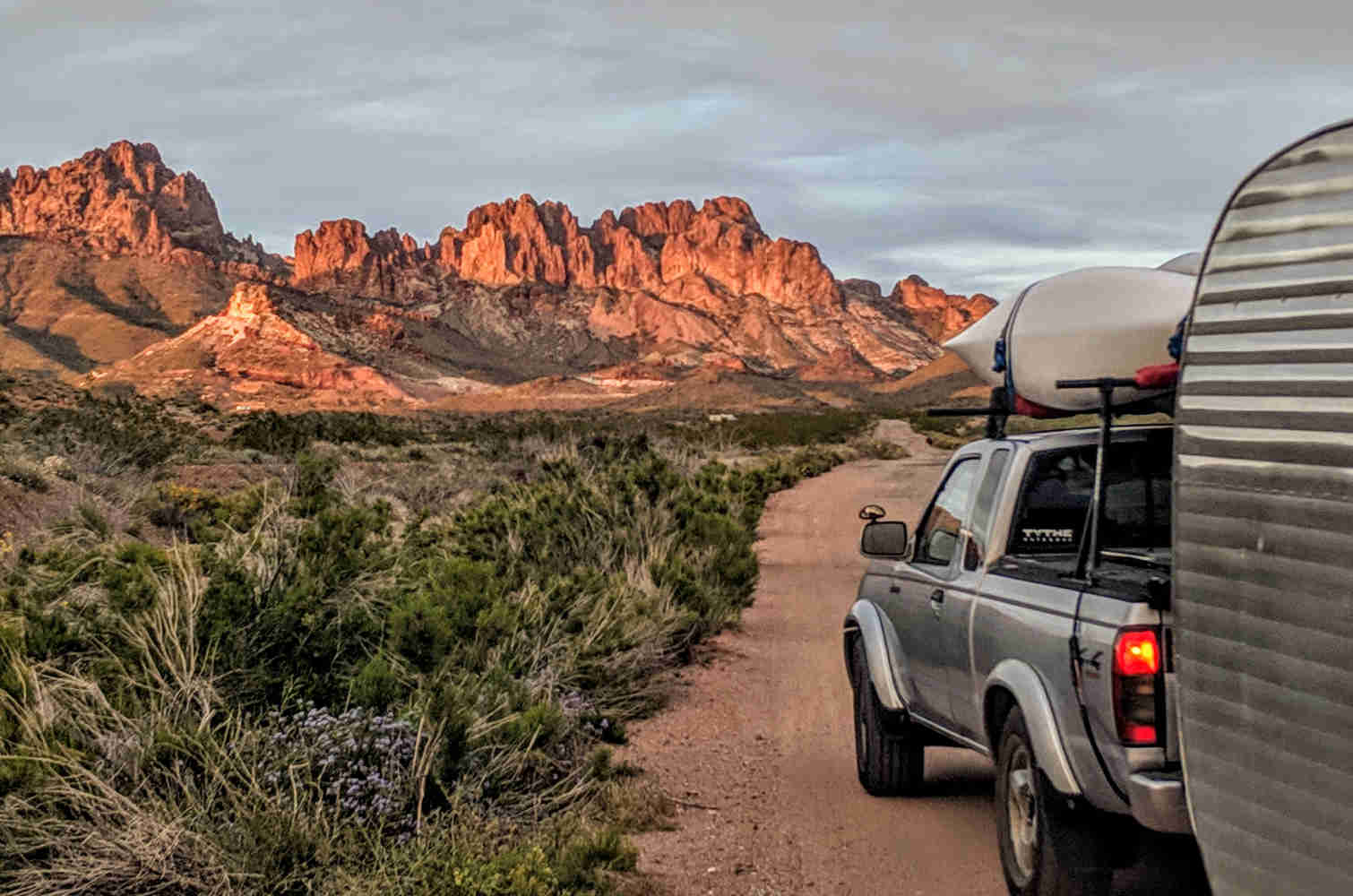
We pulled into Zion National Park right after the Memorial Day rush, and even though visitor numbers were back down to the “ordinary busy,” the campgrounds were still completely full. No worries, we drove just a bit out of town along the Virgin River to some BLM recreation land and camped there. Each day we’d drive into the park and stay into the evening before heading back to our free campsite along the rim of the river’s canyon.
National Parks are a major draw for campers of all kinds. Countless people from around the world dream about buying or renting an RV and visiting these natural treasures. With online reservations in popular parks, campgrounds fill up months in advance, especially those with any services. You may be fast on making reservations, but there’s always someone faster.
Not having a reservation won’t keep us away from a park even on a busy summer weekend. We just have to roll with it. Sometimes we’ll snag the last available site, other times we find camping just outside the park in the national forests that buffer many of the larger parks and simply bike in.
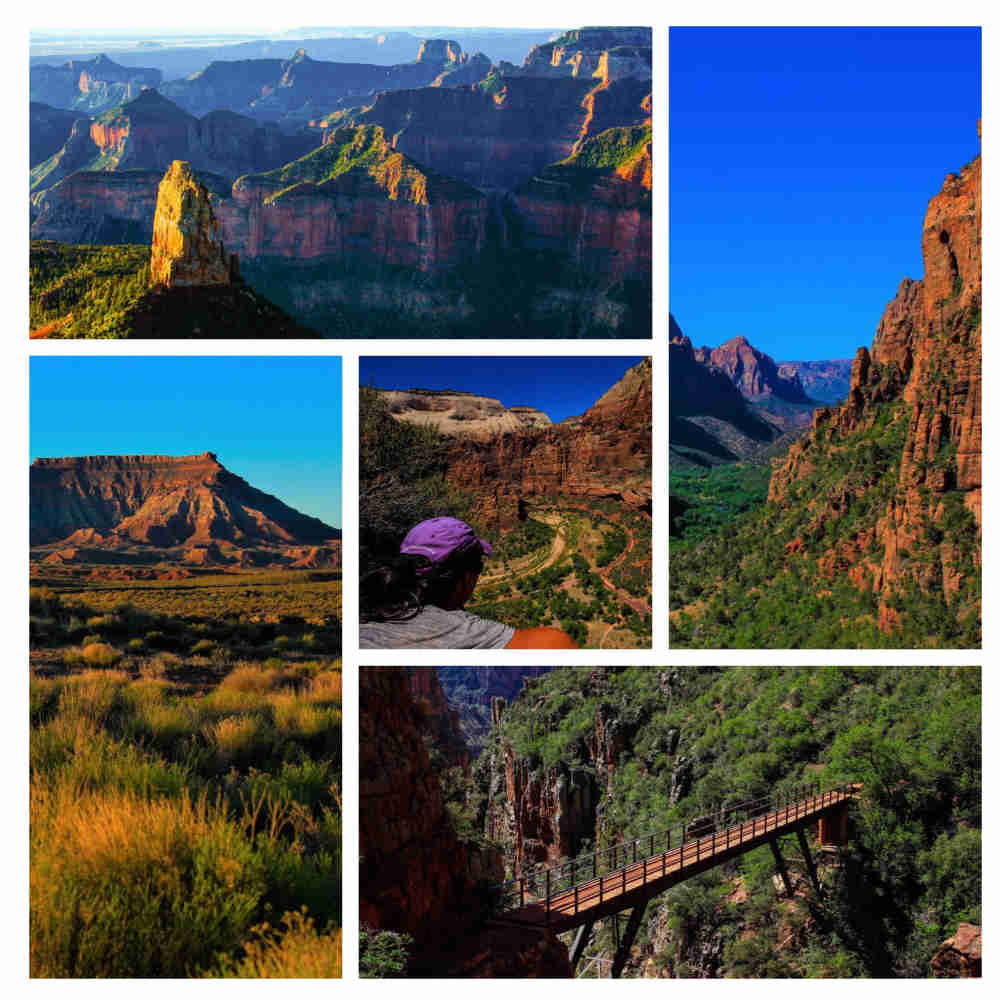
Before we even drove into the North Rim of Grand Canyon National Park, we were told by fellow travelers to not even bother if we didn’t have reservations. We didn’t have one, and there were none available, but we knew the millions of acres in the Kaibab National Forest just north of the park probably had some places to tuck our little home for a few days. We found a lovely clearing, a private meadow just off the main road with an established fire ring and all the solar gain we could want.
Many national parks offer very few sites with electrical or water hook-up, and many restrict where you can run a generator. These policies aren’t intended to keep energy hogging RV’s out of the parks, rather they are intended to limit the impact on the natural environment of the park we’ve all come to enjoy. Nobody’s camping dreams involve listening to a running generator, or crammed into a parking space between other groups. Having an RV, van, trailer, or tent running on solar power means that your options for camping are nearly limitless. Avoid the crowds, get out there and find your own favorite places!

